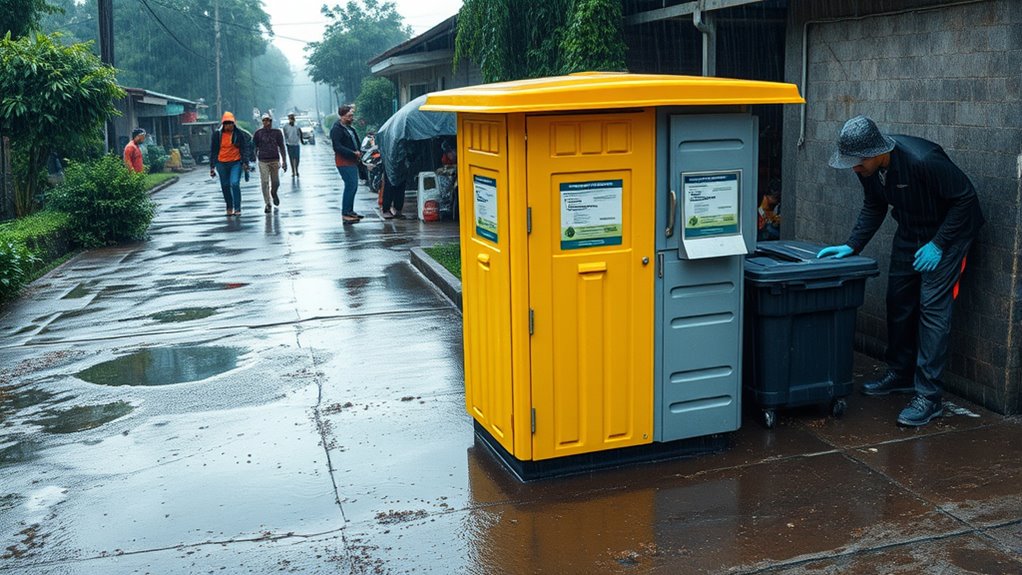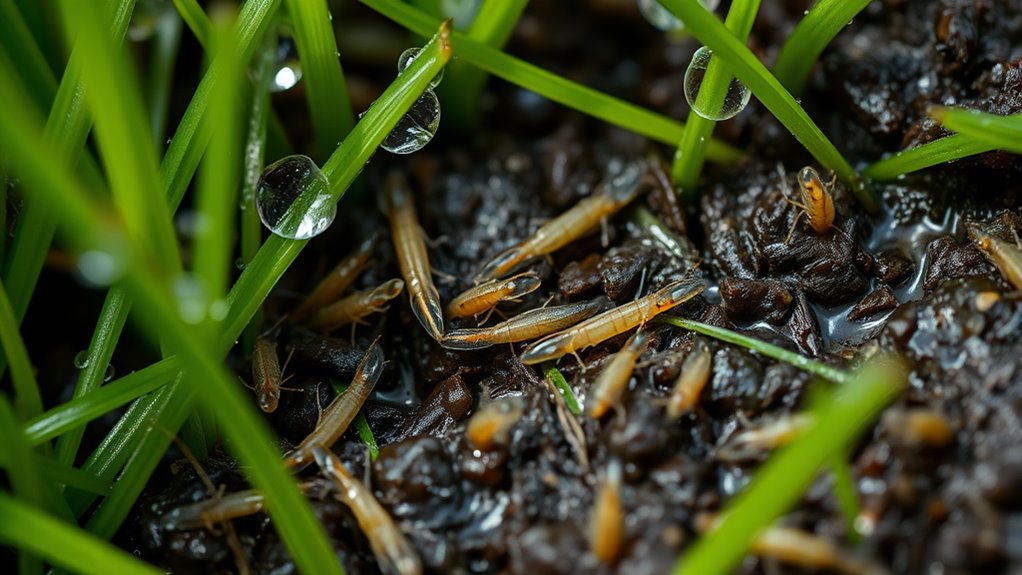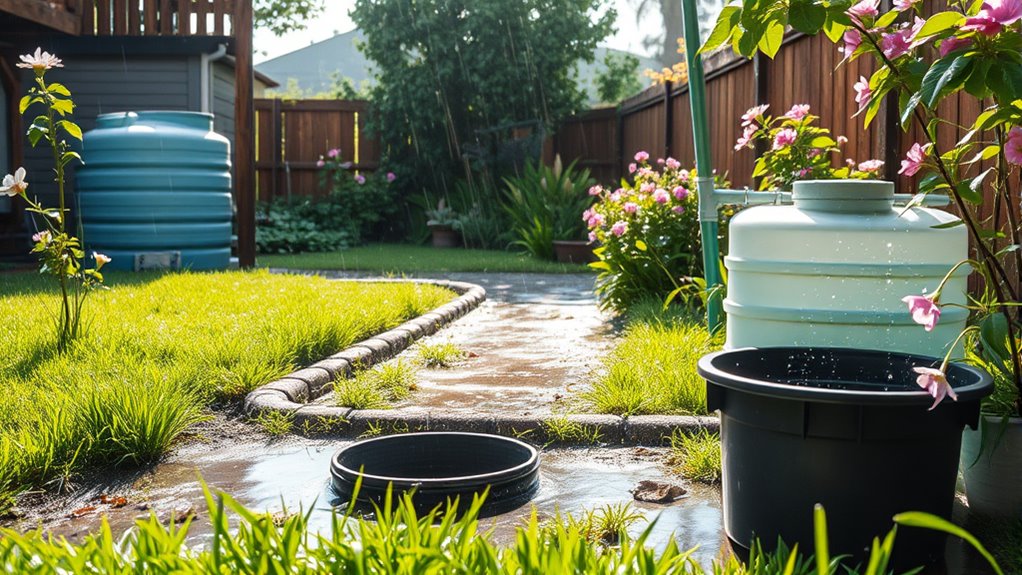As weather turns wet, you can prevent parasite outbreaks by eliminating standing water, maintaining good sanitation, and keeping pet and livestock areas dry. Regularly clean and disinfect surfaces, dispose of waste properly, and consider using biological control methods. It’s important to monitor your animals for signs of infestation early and work with veterinary or pest control experts. For an extensive plan that adapts to changing conditions, keep exploring effective strategies to stay ahead of parasites.
Key Takeaways
- Eliminate standing water and improve drainage to reduce parasite breeding sites.
- Regularly clean and disinfect pet and livestock areas to prevent habitat buildup.
- Implement routine deworming and health checks for animals before wet weather peaks.
- Manage waste properly by sealing containers and removing debris to deter pests.
- Collaborate with veterinary and pest control experts to develop adaptive, integrated parasite prevention plans.
Understanding How Wet Weather Promotes Parasite Growth

Wet weather creates ideal conditions for parasites to thrive and spread. You’ll notice that rain-soaked environments provide the moisture parasites need to survive longer outside of hosts. Puddles, muddy soil, and damp surfaces become breeding grounds, increasing the chances of parasites attaching to animals or humans. Excess water also promotes the growth of fungi and bacteria that can weaken hosts, making them more vulnerable to parasitic infections. Additionally, wet conditions often lead to overcrowded shelters and poor drainage, which further concentrate parasites and hosts in close proximity. This environment accelerates the transmission cycle, allowing parasites to multiply rapidly and establish a foothold in the area. Recognizing the importance of hygiene practices can significantly reduce the risk of infection during these conditions. Understanding these conditions helps you recognize the heightened risk during wet weather and take proactive steps.
Key Practices for Maintaining Sanitation in Damp Conditions

To keep parasites at bay in damp conditions, you need to stick to regular sanitation routines and make certain waste is disposed of properly. Using dry storage techniques helps prevent moisture buildup that encourages parasite growth. Proper storage practices are essential for controlling humidity levels and reducing the risk of infestations. By focusing on these key practices, you can effectively maintain a clean environment and reduce outbreak risks.
Regular Sanitation Routines
Maintaining regular sanitation routines is essential for preventing parasite outbreaks, especially in damp conditions where moisture encourages growth. Consistently cleaning surfaces, tools, and equipment removes dirt, debris, and potential parasite habitats. Establish a schedule to disinfect high-touch areas frequently, ensuring no spots are overlooked. Use effective cleaning agents suited for damp environments to inhibit mold and bacteria. To help, here’s a quick overview:
| Task | Frequency | Key Point |
|---|---|---|
| Clean surfaces | Daily or after use | Prevents parasite buildup |
| Disinfect tools | Weekly | Stops transmission via equipment |
| Ventilate areas | Regularly, especially after rain | Reduces moisture accumulation |
Sticking to these routines keeps damp areas dry and parasite-free. Ensuring proper ventilation is crucial in maintaining dry conditions and preventing parasite proliferation.
Proper Waste Disposal
Proper waste disposal plays an essential role in keeping damp environments free of parasites. When waste isn’t managed properly, it becomes a breeding ground for insects and rodents that carry parasites. Always dispose of household and yard waste promptly, using sealed containers to prevent pests from accessing it. Regularly clean trash bins and surrounding areas to eliminate lingering odors that attract pests. Avoid dumping waste in open areas, especially near water sources or food supplies. Compost organic waste carefully, ensuring it’s covered and maintained at appropriate temperatures to prevent pest attraction. Proper disposal reduces breeding sites and minimizes parasite risks. Additionally, maintaining proper butter-making tools and techniques can help reduce contamination risks in food preparation environments. By staying vigilant and managing waste responsibly, you protect your environment and reduce the chances of parasite outbreaks during wet weather.
Dry Storage Techniques
Effective dry storage techniques are essential for preventing moisture buildup that can lead to mold, pests, and parasite proliferation. Keep your storage areas clean, organized, and elevated off the ground to guarantee good airflow. Use airtight containers to protect your supplies from humidity and pests. Regularly inspect stored items for signs of moisture or contamination, and promptly remove any compromised products. Ensure proper ventilation in storage spaces, especially in damp or enclosed areas, to reduce humidity levels. Avoid stacking items too tightly, which can trap moisture and restrict air circulation. Maintain a stable temperature and humidity to inhibit parasite development. By following these practices, you create a dry environment that discourages pests and parasites, safeguarding your supplies and promoting overall sanitation.
Effective Parasite Prevention Strategies for Pets and Livestock

To prevent parasite outbreaks in your pets and livestock, implementing a proactive health management plan is essential. Regular deworming schedules tailored to your animals’ needs can considerably reduce parasite loads. Maintain clean, dry living areas to minimize breeding grounds and reduce exposure. Use veterinarian-approved treatments and follow dosage instructions carefully. Incorporate rotational grazing for livestock to prevent parasite buildup in pastures. Ensure proper nutrition to boost immune responses. Regular fecal exams help detect infestations early. Here’s a strategy overview:
| Strategy | Implementation Tips |
|---|---|
| Routine Deworming | Follow vet recommendations, keep records |
| Environmental Hygiene | Clean bedding, remove manure promptly |
| Pasture Management | Rotate grazing areas, avoid overstocking |
| Nutritional Support | Provide balanced diets to strengthen immunity |
| Regular Monitoring | Conduct fecal tests, observe animal behavior |
Recognizing Early Signs of Parasite Infestation

Watch for unusual behaviors in your animals, such as excessive scratching or restlessness, which can signal an infestation. Keep an eye out for visible skin irritations like redness, swelling, or sores. Recognizing these early signs helps you take swift action to prevent a full-blown outbreak.
Unusual Animal Behavior
Unusual animal behavior can often be an early warning sign of a parasite infestation. If your pet suddenly becomes lethargic or loses interest in play, it might be a sign that parasites are affecting their health. Watch for excessive scratching or biting, especially around the ears, tail, or paws, which indicates discomfort. Unexplained weight loss or diarrhea can also signal parasites disrupting your pet’s digestion. Notice if your animal seems unusually restless or irritable; they may be trying to scratch or bite to relieve irritation. Changes in appetite—either increased hunger or refusal to eat—are red flags. Recognizing these behavioral shifts early helps you seek prompt veterinary care, reducing the risk of a parasite outbreak spreading within your household. Regular preventive measures can help keep parasites at bay and protect your pet’s health.
Visible Skin Irritations
Visible skin irritations are often the first signs that your pet may be infested with parasites. You might notice redness, swelling, or raw patches on their skin, especially around the ears, belly, or paws. Scratching excessively or biting at certain areas indicates discomfort and could signal fleas, ticks, or mites. Watch for hair loss in patches, which often results from scratching or biting. Small bumps, scabs, or crusty spots may also appear, further suggesting an infestation. These signs can develop quickly, especially in wet weather when parasites thrive. Regularly inspecting your pet’s skin helps catch issues early. If you notice any irritations or changes, act promptly by consulting your veterinarian to confirm the cause and start treatment. Understanding parasite behavior can also help in implementing effective prevention strategies.
Environmental Management Techniques to Reduce Breeding Sites

Effective environmental management plays a crucial role in reducing breeding sites for parasites. You can substantially cut down parasite populations by following these strategies:
- Regularly eliminate standing water in containers, gutters, and low-lying areas to prevent mosquito breeding.
- Maintain your yard by trimming dense vegetation and removing debris that can hold water or provide shelter.
- Cover or drain any potential water collection points, such as unused tires or buckets, to disrupt parasite life cycles.
- Utilizing environmental control techniques, such as introducing natural predators or biological agents, can further reduce parasite populations and break their breeding cycles.
Collaborating With Veterinary and Pest Control Professionals

Partnering with veterinary and pest control professionals enhances your efforts to control parasite populations. These experts bring specialized knowledge and tools that you may not have, such as effective treatments and targeted strategies. Regular veterinary checkups ensure your animals are properly protected and treated for parasites, preventing outbreaks before they start. Pest control specialists can identify and eliminate breeding sites around your property, reducing the overall parasite load. Working together, you can develop integrated plans that include proper medication schedules, habitat modifications, and ongoing monitoring. Building a relationship with these professionals also keeps you informed about emerging threats and new prevention methods. Their expertise complements your efforts, making your parasite control more effective and sustainable, especially during wet seasons when outbreaks are more likely. Developing a comprehensive creative practice approach can further enhance your ability to adapt and respond to unexpected challenges in parasite management.
Frequently Asked Questions
How Do Parasites Survive Extreme Weather Conditions?
Parasites survive extreme weather by adapting their life cycles and seeking protective environments. You’ll find them hiding in soil, water, or host organisms, which shield them from harsh conditions. Some produce resistant eggs or cysts that withstand temperature swings and dryness. By doing so, they guarantee their survival and can thrive once conditions become favorable again, making it essential for you to take preventive measures during unpredictable weather.
Are Certain Breeds More Resistant to Parasite Outbreaks?
You know what they say, “A healthy dog is a happy dog.” Certain breeds do show more resistance to parasite outbreaks due to genetic factors. For example, some breeds have tougher immune systems or skin that’s less inviting to parasites. However, no breed is entirely immune. Regular vet checkups, proper hygiene, and parasite prevention are essential, regardless of your dog’s breed, especially as weather becomes wetter.
What Are Cost-Effective Methods for Large-Scale Parasite Control?
You can implement cost-effective parasite control by regularly rotating pasture areas to break parasite life cycles, applying targeted treatments based on fecal testing, and maintaining good sanitation practices. Using strategic deworming schedules helps reduce drug use and resistance. Additionally, encouraging natural resistance through proper nutrition strengthens animals’ defenses. Educate yourself on parasite risks and stay vigilant, so you can act promptly and minimize costs while protecting your livestock effectively.
Can Climate Change Influence Future Parasite Outbreaks?
Climate change can definitely influence future parasite outbreaks by creating warmer, wetter conditions that support parasite survival and spread. You’ll see more frequent, intense outbreaks as these environmental changes expand the habitats suitable for parasites, increase their reproduction rates, and extend their active seasons. To stay ahead, you need to monitor weather patterns, adapt your control strategies, and implement proactive measures that reduce risks before outbreaks occur, protecting your community effectively.
How Can Community Efforts Enhance Parasite Prevention?
You can enhance parasite prevention by staying informed and encouraging your community to adopt good hygiene practices. Organize awareness campaigns, promote proper waste disposal, and support local efforts to improve sanitation. Getting involved in neighborhood clean-up events and advocating for regular health check-ups also help. By working together, you reduce parasite habitats and transmission risks, creating a healthier environment for everyone. Your active participation makes a significant difference.
Conclusion
As wetter weather creates ideal conditions for parasites, staying vigilant is essential. Did you know that studies show parasite populations can increase by up to 50% during rainy seasons? By practicing good sanitation, monitoring your pets and livestock, and working with professionals, you can drastically reduce the risk. Don’t let damp conditions turn into a parasite outbreak—take proactive steps now to protect your animals and your environment.










